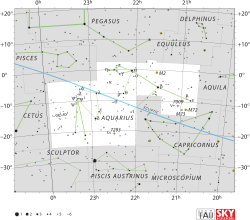83 Aquarii

| |
| Observation data Epoch J2000 Equinox J2000 | |
|---|---|
| Constellation | Aquarius |
| Right ascension | 23h 05m 09.78684s[1] |
| Declination | –07° 41′ 37.6853″[1] |
| Apparent magnitude (V) | 5.43[2] (6.20/6.34)[3] |
| Characteristics | |
| Spectral type | F2 Vn + F2 V[3] |
| U−B color index | +0.07[2] |
| B−V color index | +0.30[2] |
| Astrometry | |
| Radial velocity (Rv) | –13[4] km/s |
| Proper motion (μ) | RA: +122.41[1] mas/yr Dec.: +7.11[1] mas/yr |
| Parallax (π) | 15.57 ± 0.61[1] mas |
| Distance | 209 ± 8 ly (64 ± 3 pc) |
| Orbit[5] | |
| Companion | 83 Aquarii B |
| Period (P) | 21.840 ± 0.019 yr |
| Semi-major axis (a) | 0.2026 ± 0.0007" |
| Eccentricity (e) | 0.3878 ± 0.0025 |
| Inclination (i) | 48.01 ± 0.42° |
| Longitude of the node (Ω) | 204.87 ± 0.50° |
| Periastron epoch (T) | 1983.108 ± 0.022 |
| Argument of periastron (ω) (secondary) | 82.83 ± 0.45° |
| Other designations | |
| Data sources: | |
| Hipparcos Catalogue, CCDM (2002), Bright Star Catalogue (5th rev. ed.) | |
83 Aquarii (abbreviated 83 Aqr) is a binary star system in the equatorial constellation of Aquarius. 83 Aquarii is its Flamsteed designation though it also bears the Bayer designation of h Aquarii. The combined apparent visual magnitude of the pair is 5.43,[2] which is faintly visible to the naked eye. Based upon an annual parallax shift of 15.57 milliarcseconds,[1] it is located at a distance of around 209 light-years (64 parsecs) from Earth.
Both stars are F-type main sequence stars.[3] The first component has an apparent magnitude of 6.20; the second is magnitude 6.34.[3] They are orbiting each other with a period of 21.84 years with an eccentricity of 0.388.[5]
References
- 1 2 3 4 5 6 van Leeuwen, F. (November 2007), "Validation of the new Hipparcos reduction", Astronomy and Astrophysics, 474 (2): 653–664, arXiv:0708.1752
 , Bibcode:2007A&A...474..653V, doi:10.1051/0004-6361:20078357.
, Bibcode:2007A&A...474..653V, doi:10.1051/0004-6361:20078357. - 1 2 3 4 Nicolet, B. (October 1978), "Catalogue of homogeneous data in the UBV photoelectric photometric system", Astronomy and Astrophysics Supplement Series, 34: 1–49, Bibcode:1978A&AS...34....1N.
- 1 2 3 4 Eggleton, P. P.; Tokovinin, A. A. (September 2008), "A catalogue of multiplicity among bright stellar systems", Monthly Notices of the Royal Astronomical Society, 389 (2): 869–879, arXiv:0806.2878
 , Bibcode:2008MNRAS.389..869E, doi:10.1111/j.1365-2966.2008.13596.x.
, Bibcode:2008MNRAS.389..869E, doi:10.1111/j.1365-2966.2008.13596.x. - ↑ Wilson, Ralph Elmer (1953), General Catalogue of Stellar Radial Velocities, Washington: Carnegie Institution of Washington, Bibcode:1953GCRV..C......0W.
- 1 2 Hartkopf, W. I.; Mason, B. D.; McAlister, H. A. (1996), "Binary star orbits from speckle interferometry. VIII. Orbits of 37 close visual systems", Astronomical Journal, 111: 370–392, Bibcode:1996AJ....111..370H, doi:10.1086/117790.
- ↑ "83 Aqr -- Star", SIMBAD Astronomical Database, retrieved 2007-07-14
External links
This article is issued from Wikipedia - version of the 6/6/2016. The text is available under the Creative Commons Attribution/Share Alike but additional terms may apply for the media files.